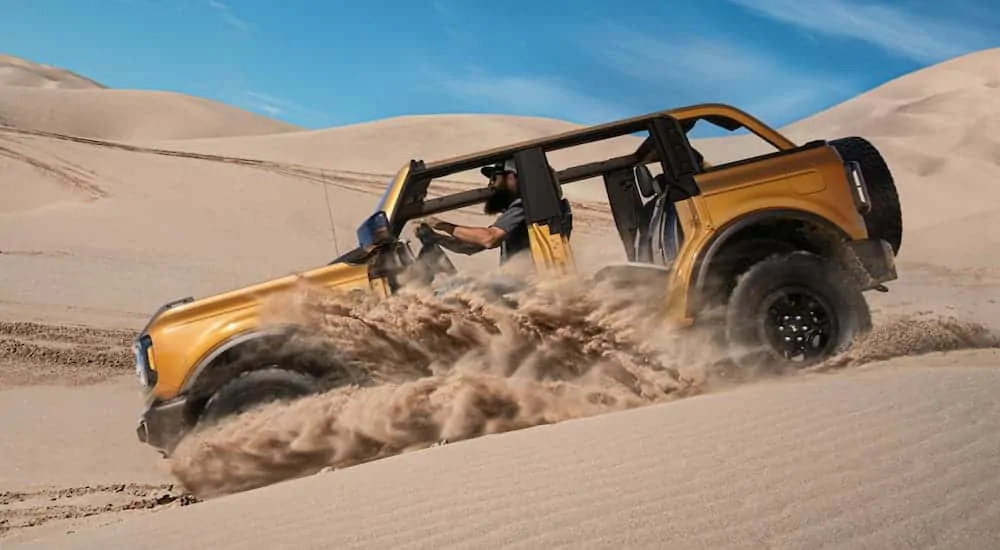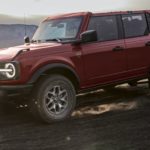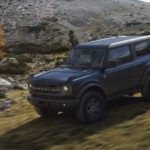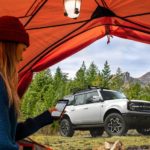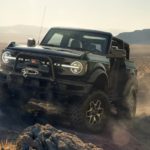With the recent return of the Ford Bronco, there’s been plenty of heated debate about whether the Bronco or the Jeep Wrangler is the better off-road SUV. For decades now, Jeep pretty well had that title locked down with very little real competition from the other big manufacturers. The Ford Bronco changed all of that, however, as it was clearly designed with an anything-you-can-do-I-can-do-better attitude on display. From its impressive off-road performance and design to the similar open-air cabin that features removable doors, the Bronco seems to be delivering on what a lot of people were hoping to see in Jeep innovation that never came (lack of real competition can do that to a company).
It seemed like Jeep was recognizing this and looking to “fire back,” with recent reveals like the Wrangler Rubicon 392, the most powerful Jeep Wrangler ever. I’ll admit that when I first saw the Rubicon 392, I was impressed – who doesn’t want a HEMI V8 engine in an off-road machine? And yet, Ford just delivered its own response: the Bronco Raptor, designed as a performance-focused off-road machine. While it might lack a V8 engine, that’s about the only thing the Rubicon 392 still has to brag about by comparison. Let’s take a look at what the Bronco Raptor is going to deliver and see how it compares to Jeep’s offering – particularly the Rubicon 392.
Engines Head-to-Head
I’m going to start with the one thing that Jeep really has going for it at this point: they finally got around to plopping one of their HEMI engines into the Wrangler. It’s only available on the Rubicon 392 model, of course, but that’s still something; it’s a 6.4L HEMI V8 that delivers 470 hp and 470 lb-ft of torque. With this engine, the Wrangler can go from 0 to 60 in just 4.5 seconds, and it can run the quarter-mile in 13 seconds. That’s all very impressive performance for an SUV designed for the trail – but it does raise the question of whether those kinds of track-focused performance specs really matter if you’re going to be rock crawling and splashing through creeks while enjoying your vehicle.
By comparison, the recently-announced Ford Bronco Raptor will feature a 3.0L twin-turbo EcoBoost V6 engine rather than a V8. Ford hasn’t announced official performance specs on it just yet, but they’re saying it will offer somewhere north of 400 hp. This is essentially the same engine Ford offers on the Explorer ST, though it’s been twin-turbocharged here; in the Explorer ST, the engine delivers 400 hp and 415 lb-ft of torque, so that’s the bare minimum we should probably expect. Still, at the end of the day, some people might scoff a bit at the V6 compared to the Rubicon 392’s HEMI.
If you’re just looking at the raw numbers, then that’s definitely fair. This is a pretty clear win for Jeep and their Wrangler (they need it); I doubt the Bronco Raptor will beat the Rubicon 392 off the line any time soon or win in a quarter-mile race. And there’s something to be said for that. But unless you’re just looking for a mall crawler that can handle all of the rigorous demands of a high school parking lot, you’re interested in a Wrangler or Bronco for more practical reasons: hitting the trail.
Off-Road Functionality
Let’s be honest: bragging about 0 to 60 speeds on an off-road machine is fine, but that’s not going to matter when you’re navigating rocky terrain or zipping along sand dunes. I can’t help but feel like the HEMI V8 in the Rubicon 392 is a bit of a gimmick in this regard. Yes, people were asking for a Wrangler with more power for a long time – but I imagine they wanted that power to be combined with unsurpassed off-road capability.
The Rubicon 392 has good ground clearance, at 10.3 inches, but that’s actually about a half-inch lower than the standard Wrangler Rubicon. It has front and rear locking differentials, and Jeep has bragged a lot about its disconnecting sway bar and “massive articulation of the front tires” (you’ll see this phrase used a lot in their marketing), yet finding the actual numbers for suspension travel from Jeep seems to be impossible. Jeep likes to brag about it but not actually cough up the specs on it.
In contrast to this, Ford has been very forthcoming about all of the specs on the Bronco Raptor with regard to its off-road abilities. For starters, it puts the Rubicon 392’s ground clearance to shame: the Bronco Raptor has more than 13 inches of clearance; that’s nearly a full three inches more than the 392. Where the Rubicon 392 has reduced clearance compared to the standard Rubicon, the Bronco Raptor has been designed with slightly greater clearance than the standard Bronco. And that’s just the beginning…
The Bronco Raptor features Ford’s High-Performance Off-Road Stability Suspension (HOSS) and FOX Live Valve technology in the FOX 3.1 Internal Bypass Semi-Active Dampers to create one of the most impressive suspension systems available. It has 13 inches of front suspension travel and 14 inches of rear suspension travel, plus a design that gives you an approach angle of more than 47 degrees. All that and it comes with Ford’s Goes Over Any Type of Terrain (GOAT) Modes system that features seven modes for terrain management that really does let it do anything the Wrangler can and much more.
Wheels and Tires
I already mentioned ground clearance and a lot of other off-road capabilities, but I can’t help but continue to marvel at how well Ford’s team designed the Bronco Raptor to surpass what the Jeep Wrangler, even the Rubicon 392, has to offer. The Bronco Raptor comes with 17-inch wheels, beadlock-capable wheels are available, and 37-inch tires standard. Every model has these massive tires on it that immediately convey the fact that this beast is designed for climbing over anything you throw at it.
By comparison, the Jeep Wrangler Rubicon also has 17-inch wheels, thankfully, but it comes with 33-inch tires standard. There are 35-inch tires available, but it’s kind of ridiculous that you have to pay more for an available package to still get tires that are smaller than what comes standard on the Bronco Raptor. To be fair, this isn’t the biggest game-changer, and I’m really not interested in seeing a wheel-size cold war erupt between manufacturers; it simply showcases one more way the Bronco Raptor has been designed to surpass the Wrangler.
Cabin Design and Features
This also comes through in the design and features you get inside these vehicles. For years, one of the biggest complaints people have had about the Wrangler is that you lose the side mirrors when you remove the doors. Ford recognized this and designed the Bronco to have the side mirrors on the body itself, so you can remove the doors and keep your visibility intact. Jeep is yet to respond with a design that fixes this – it’s a clear example of Ford going a step further.
Inside these two vehicles, you get dramatically different experiences. The Rubicon 392 comes with an 8.4-inch infotainment display and a paltry 7-inch digital instrument cluster – those sizes are what you’d expect from a starting trim or an economy model, not a powerful flagship that should be all about bragging rights. In contrast to this, the Ford Bronco Raptor comes with a 12-inch infotainment screen and a 12-inch digital instrument cluster. It’s a night-and-day difference that reveals how far behind the Wrangler really is.
Where Can Jeep Go from Here?
The differences here are pretty shocking. They become even more startling when you combine all of this with the fact that the Bronco Raptor is looking to start at roughly $69,995 MSRP, and the Rubicon 392 starts at $75,095. From where I’m sitting, the only chance Jeep has is to get with the times and make some major changes to the Wrangler to make it competitive. They need to respond to Ford not just with a hybrid powertrain or HEMI engine (or the inevitable EV model), but with a real, fundamental change to their approach to the Wrangler. The Bronco is clearly here to stay, and Ford is going leaps and bounds ahead of what Jeep has to offer – unless something dramatic happens, and soon, I’m pretty sure Papa Stellantis isn’t going to be too pleased with sales figures over the next decade.
